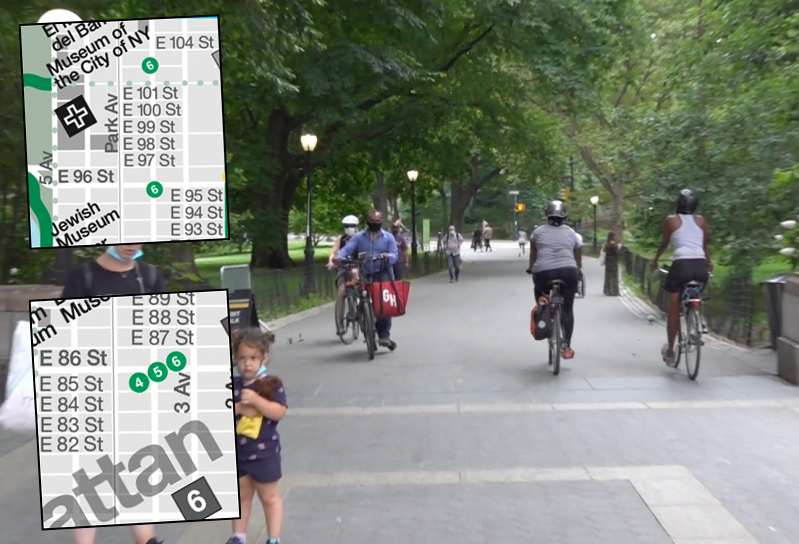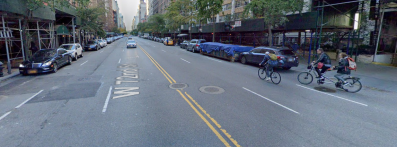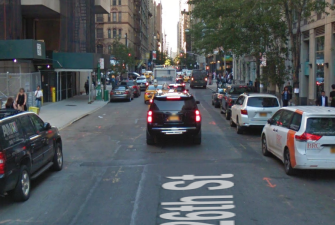OPINION: We Need a River-to-River Crosstown Bike Network in Manhattan
Let's stop discriminating in favor of motorists and give cyclists a simple, safe crosstown route.

Here’s a crucial safety idea for which cyclists are clamoring: a crosstown network of bicycle-priority corridors linking the greenways along the East and Hudson rivers and the loop in Central Park. These three shared paths — dedicated car-free mobility corridors — move thousands of people each day north and south through Manhattan, yet there’s no safe, direct way among them. Connecting them would transform how people get around Manhattan and greatly expand bike transportation.
As it stands, motorists from the New Jersey suburbs can drive 5,500-pound SUVs down the Henry Hudson Parkway and enter the Manhattan street grid at 96th Street through rights-of-way dedicated to their swift and safe passage. They can speed due east on wide arterials, cut through Central Park, and continue across Manhattan to the FDR Drive, passing undeterred through dense residential neighborhoods.
Meanwhile, a New Yorker in these neighborhoods riding a 25-pound bicycle has no equivalent option. No safe, direct, dedicated bicycle-priority route exists to get people across town to work, to school, or to Central Park less than a mile away.
The city has been slow to rectify this perverse, antiquated, car-centric arrangement. The dense street grid from 59th to 110th streets lacks dedicated crosstown bicycle infrastructure — a glaring omission given the proximity to schools and parks and the passage north and south of thousands of daily bicycle commuters. Examples from across the world, and even here in the city, show how this could change quickly with political will. Given the city’s equity and climate goals, now is the time to correct this.
Imagine a bike network that takes its cues from the greenways: generous, car-free spaces welcoming to all ages and abilities. By creating bicycle-priority corridors, rather than skimpy bike lanes stolen from the margins of car lanes, we can value active transportation users and evolve how we think about bicycle infrastructure.
The connected crosstown bicycle corridors should follow three simple rules:
- Be fully separated from motor vehicles.
- Be wide enough to accommodate social cycling and a mix of abilities and speeds.
- Bicycles should have priority over cars and trucks wherever they cross paths.
Here’s a test: Would you feel comfortable with your 8-year-old child or 80-year-old parent riding here? If so, that’s the kind of infrastructure we’re talking about.
Under current conditions, riding a bicycle across town is loud, dirty, and dangerous. By forcing cyclists to mix with multi-ton vehicles on every street, the city’s unmistakable message is, “Ride at Your Own Risk.” Even though many people accept these risks (some, like working cyclists, don’t have a choice), many more simply won’t ride on a street next to cars and trucks. It’s just too scary. The tragic, and preventable, deaths of Dr. Daniel Cammerman in 2019 and Carling Mott just last month are a sad reminder that such fears are well founded.
Studies prove that people (especially women) ride more frequently when they feel safe. Provide more car-free space and more people will get on bikes. The growth of cycling in cities like Paris, London, and Montreal bears this out. Closer to home, look no further than Summer Streets, when hundreds of thousands of people fill Park Avenue for a few glorious hours when the DOT banishes cars. It’s also evident daily on the Central Park Loop and Hudson River Greenway — where people choose to ride because they know they can ride comfortably and safely. In fact, many people we’ve talked to will only ride on the greenways where they’re separated from cars. Let’s provide car-free space to connect them.
https://twitter.com/BarmanNYC/status/1554411341183582208?s=20&t=HkqicjzYUBAoW9qA9TPYwQ
A Chinese proverb goes: “The best time to plant a tree was 20 years ago. The second-best time is now.” The same goes for replacing car infrastructure with bike infrastructure. Unlike trees, however, bike lanes can grow quickly, given political courage. A crosstown route along 72nd Street could be piloted tomorrow using orange cones and signage. Same with Fifth Avenue. We can’t afford to wait for years and decades of planning and studies to get concrete poured — we’ll never have a mature network.
Picture it: a network of right-of-ways dedicated to the swift, safe passage of people on bikes from the East to the Hudson rivers and around Central Park. Imagine the transformation. Let’s make it happen.
Paul Krikler (@PaulKrikler) is a cycling advocate and co-chair of Transportation Alternatives Manhattan Activist Committee. Carl Mahaney (@measuredworks) is livable-streets advocate and director of StreetopiaUWS.

